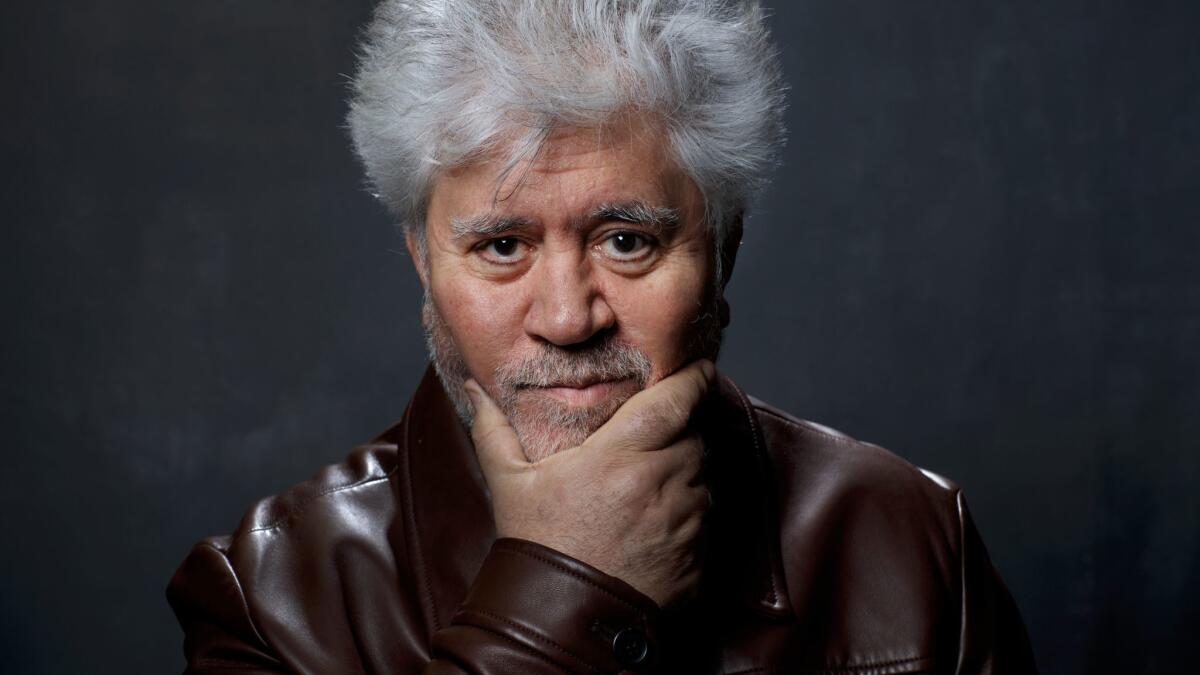Pedro Almodovar crosses cultural divides to tell a story of loss in ‘Julieta’

- Share via
Considering the sometimes unbridled stylistic and emotional wildness of Pedro Almodóvar’s work, the apparent simplicity of his new film comes as a change-up. Inspired by three Alice Munro short stories, “Julieta” can be taken as a lesson in translation.
“The one thing one must not see the film as is a direct adaptation,” says the auteur at the Blvd restaurant at the Beverly Wilshire Hotel. “I think the tone of Alice Munro’s stories really impregnated my being. So even though her stories seem very simple, her simplicity is never simple and there are always things within things. And that’s very present in the film.”
One way to measure the transformation of the stories (“Chance,” “Soon” and “Silence”) from Munro’s 2004 collection, “Runaway,” into “Julieta” is by temperature. And then, in careful calibration by degrees.
“I’m conscious that the Julieta in my movie is much warmer than the original Juliet in Alice Munro,” says Almodóvar. “If I did directly what is in the stories, it’s almost unbearable. When Juliet visits her relatives with her little girl [in “Soon”], the coldness with which Juliet treats her mother is just terrible.”
The Spanish filmmaker’s English is perfectly fine, and expressive, but he still turns to translator Carla Marcantonio for assistance at times. That’s fitting in discussion of a film originally intended to be his first in English, Munro’s language. As the stories each check in on the same woman at different points in her life but are otherwise narratively unconnected, Almodóvar planned for Meryl Streep to play the character at all three stages.
He found, however, some key components didn’t translate. He eventually chose to relocate the Canadian stories to Spain and to cast two actresses (Adriana Ugarte and Emma Suárez) as Julieta through the years. He took many liberties with the material, as in the segment based on “Soon.”
“What gives that story its name is when her mother is speaking to Juliet about her problems and she says, ‘But I know it’ll all be fine because Juliet will arrive soon.’ And Juliet, instead of reassuring her: ‘Of course, Mother, I will always be there,’ she just stays quiet. And leaves.
“For me, it was impossible not to include a sentiment of guiltiness. That guiltiness is part of the culture to which I belong; it’s not in Alice Munro’s stories. When I tried to make it in English, it didn’t fit. When I decided to make it in Spanish, then everything fit together. I couldn’t write this sequence with the mother – it’s so terrible, so cruel, I didn’t find a way to do it in Spanish.
He’s quick to explain he has no moral objection to Munro’s scenario; just a cinematic one. And a cultural one.
“As a director, I actually didn’t feel capable of shooting such a cruel sequence. It doesn’t belong to the Spanish way of behaving around family. The moment I decided to adapt it to a very specific Spanish context and culture and geography, many of Alice Munro’s elements had to disappear or be transformed.”
“Julieta” deals deeply with loss. So despite the protagonist’s rise in emotional temperature from the Munro version, Almodóvar recommended some distinctly cold works of art for his actresses’ inspiration. These included Joan Didion’s devastating chronicle of the deaths of her husband and daughter, “The Year of Magical Thinking,” and the paintings of Lucian Freud, who once said of his sometimes uncomfortably penetrating portraits, “I paint what I see, not what you want me to see.”
“That was part of the austerity with which I was wanting to narrate the film,” says Almodóvar. “For example, there’s a scene where Julieta looks through the garbage and the only witness to what she’s doing is a painting of Lucian Freud’s.”
The presence of such paintings isn’t expositional – as in, “The character has this much money, so can own a Freud” – the director used them compositionally.
For instance, when Julieta has to tell someone something difficult, “On the wall, there is a big painting – everything is black – by Richard Serra,” the director says of the visual artist known for his stark, sometimes monochrome works, including Holocaust memorials. “She comes into the painting, she’s floating into this material, blackness, to give awful news. It was her, the painting and the tragedy she’s going to tell. The blackness of the painting helps me narrate.”
See the most read stories this hour »
More to Read
Sign up for The Envelope
Get exclusive awards season news, in-depth interviews and columnist Glenn Whipp’s must-read analysis straight to your inbox.
You may occasionally receive promotional content from the Los Angeles Times.







